Updated: 13-May-2019
In 1904, Catalan industrialist Damian Mateu and others, are associated with Swiss engineer Marc Birkigt, born in Geneve (Switzerland) and together they founded the "Hispano-Suiza" firm in Barcelona with the intention of manufacturing quality and prestige automobiles
-Actually, they acquired the unsuccessful "J. Castro Fábrica Hispano-Suiza de Automóviles" company where Marc was already working as an engineer.
-From there the name "Hispano-Suiza" was extracted.
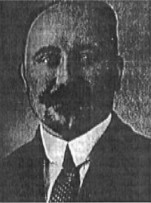
“Marc Birkigt”
-In turn, Castro had acquired it from La Cuadra, perhaps the first Spanish automobile factory, where Marc also directed the construction.

“Hispano Suiza logo on a car”
-The excellent quality of the Hispano-Suiza cars seen from the current perspective is beyond doubt. Many of them are still working today, almost 100 years later.
-The main facilities were located in Barcelona City, in the La Sagrera area, 279 Ribas road.
-In a footer of the printed book, we could see the photograph of the primitive factory and what it is today, after having passed through the hands of Enasa-Pegaso.
-It was because of the Great War of 1914/18 and on request of the Spanish authorities that the studies on aviation engines began.
-The then Colonel Vives sent several existing engines to the factory and with the help of other Spanish military engineers such as Sousa Peco and Quesada they began working on a 8-cylinder Vee-engine with the cylinder banks at 90° and a power of 140 CV.
-Very little later, the A model would give 150 CV.
-The 140 CV (Type 31) had a mixed cylinder cooling, with 11 fins in the lower part of the cylinders and water-cooling in the upper part of the cylinders and their heads.
-The 140 CV engines were used in Spain on the Flecha and "W" planes, designed by Barrón.
-I suggest reading the book about Hispano Suiza that deals partially (1914-18) by Jacinto G. Barbero, and visiting the Archive of Wifredo Ricart in Terrassa, Barcelona, Spain.
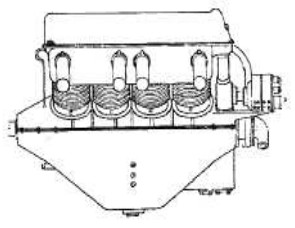
“H-S 140 CV, with 11 fins”
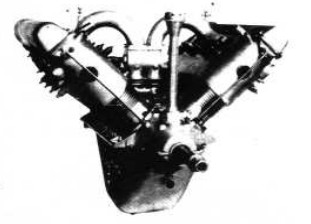
“Tipo 31, with 8 visible fins”
-In 1911 they founded a branch in Levallois-Perret, near Paris, France, with Spanish capital, passing shortly to Bois-Colombes, in 1913.
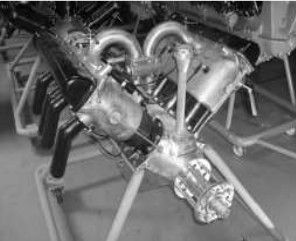
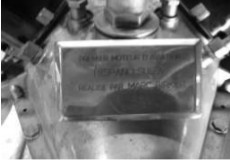
“H-S V8, with commemorative plate at the MAE”
-This V8 engine has 8 fins on the cylinders below the water-cooled blocks.
-According to the commemorative plate, it is the first V8 engine made in 1915 by Mark Birkgit. This is inaccurate.
-We know that the first ones were made in Barcelona, and they had 11 fins. Later there were several with 8. In 1911, the Paris branch was set up.
-From then Hispano Suiza in France grew more and became more important. Above all during WWI.

"Entrance gate to the Bois-Colombes factory"
-The entrance gate to the former Hispano-Suiza factory, is perfectly preserved at the Snecma/Safran Museum in Villaroche, France.
-The main metal entrance gate with the Hispano Suiza name and logo on top is still kept at the Vilaroche Museum.

“The stork logo”
-The new company, was received with hostility by established French manufacturers.
-At the time of its presentation to a military procurement tender, with their new V-8 engine, the pressure increased.
-Marc Birkigt proposed a 50-hour performance test to prove the goodness of his engine, but on the condition that the other brands did as well. The others failed and H-S even added a few more hours without any failure. This convinced the French authorities.
-There were conditions such as manufacturing in France and by other subcontractors, but they still prevailed in that country.
-This was the engine that in the WWI replaced the rotary and other engines, and gave air superiority to the allies.
-In memory of a pilot, Guynemer, who carried a stork painted on the side of his plane, the Hispano-Suiza brand adopted the same logo, even on the radiator plugs of their great automobiles.
-Later, facilities would be opened in Tarbes, also in France.
-In Spain, Hispano Suiza opened a factory in Guadalajara to build military vehicles and aircraft.
-From these engines the HA-30 and HA-34 were among the best known then. They ended up in Seville as Hispano-Aviation manufacturing other aircraft such as the Chirri and Buchón, Triana, Saeta, etc.
-The 140 CV engine attracted the attention of other countries, for its characteristics were appreciated immediately. Manufacturing licenses were awarded all over the world.
-Below some old photographs obtained from the V8 Type 31 Hispano Suiza engine, but with 11 fins at the base of the cylinders, as mentioned above.
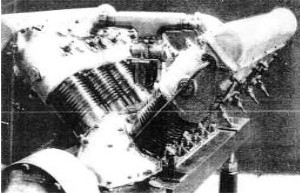
“Tipo 31, first model”
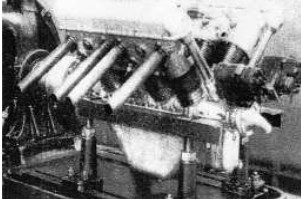
“The same T-31 engine from the side”
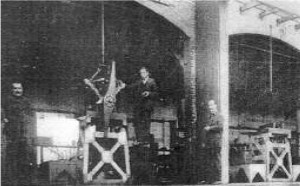
“Hispano Suiza test benches in Barcelona”
-At the Torino Politecnico there is a Hispano Suiza Type 31 engine that, as it seems, was the brand's first V-8 aviation engine that flew.
-It was done at Cuatro Vientos Airport, and this engine was destined for the Flecha planes, designed by Barrón.
-There are several people who say so, including the book of the brand's history in its first four years of the V-8 construction, written by Jacinto Garcia from the friends of the Spanish Air Museum. (Amigos del Museo del Aire)

“HS Tipo 31 with 8 fins, at the Polito”
-Probably it has had an odd story until it arrived at the Capetti collection.
-But it is their merit that the engine is conserved and did not end up in scrap.
-The conclusion that this engine was the same as it is believed, is for:
1st. It does not have the vitrified black paint that was immediately used to close the pores of the foundry defects that were produced. Although in the first ones they did not.
-The 2nd and most important for its detection are the 8 fins on the cylinder bases.
-According to J. García, to eliminate weight, the water containers of the cylinder blocks were smaller and 11 fins were used.
-These were decreasing in the different tests until being 8 on the engine in the photograph. Eventually they would have none.
-As mentioned in another point, in the Capetti collection there are two other Hispano Suiza V8 (and a V-12).
-The V-8s are Type 44, one whole and one "cutaway". They were of the "cannon engine" type with gear. The propeller shaft was hollow for using it with a weapon.
-In addition the intake manifolds and carburetor were placed higher to make room. These are the ones that were manufactured under license by Itala.

“8V, 150 CV without fins”
-The 150 CV, which was totally water-cooled, had innovative solutions such as joint cylinder blocks of cast iron. Normally, in the previous engines, the cylinders were isolated, creating breakdowns, apart from their greater weight.
-The problems that they had then with pores in the aluminum casting were solved by using fired-enamel for inner and outer coatings on the blocks. Hence, that brilliant and smooth black.

“A type A, at INTA”
-The V-8 engines proved to be very safe and powerful. Besides, they were shorter than the classic 6-cylinders inline with better forward visibility and less front area than the rotary engines of the time. The superiority was evident in its architecture.
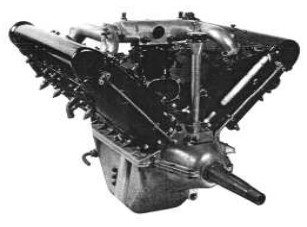
“Tipo A, 180 CV”
-As from the appearance of the 150 CV the series and powers would increase until reaching 350 CV of the Fe (45).
-Hence type A was 180 CV and was being built massively in France, in 1916. In 1917 it already reached 210 CV in the B-version. From the A model there were variants such as the Aa with 150 CV, Type 34, mounted on the Spad VII. The Ab model gave 200 CV (Type 41), the Ae gave 180 CV (Type 36bis), further the Ac, etc.

“Tipo B, cross-section”

“HS V8 Ab from 1916, at the MAE”
-The 8V B reached 200 CV in the basic version. The Bd version gave 220 CV at 2110 rpm, in 1916.
-The Bd (Type 35) gave 200 CV. The Bda gave 215 CV.
-The Be was Type 35-S. The 235 CV for the Bed is the same as for the Bec.

“Bd model”
-The illustrated Bd has a very high intake manifold. It has an appreciable gearbox, and a possibly reason for both was the use of a weapon through the center of the engine. The propeller shaft was hollow for that purpose.
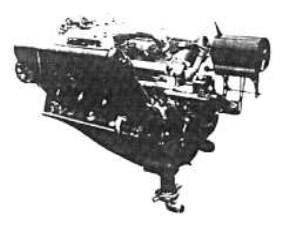
“HS, Bc model”
-In the Bc variant (Type 35bis), we see the drum that is used to store the ammunition and part of the weapon and firing system stock.
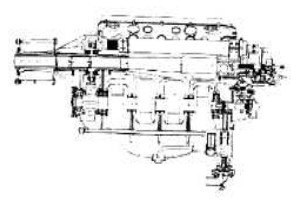
“Cross-section for the Bc”
-In the section through the center of the longitudinal plane, we can see the hole that is left for the cannon and its passage through the center of the propeller.
-We received a photography of a Hispano-Suiza V8 model 8Be that gave 220 CV, from the year 1917.
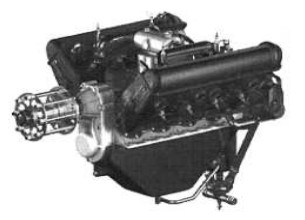
“Hispano-Suiza 8Be”

"H-S V8 with a strange front platform"
-This V8 with an unusual frontal part -it is not a gearbox- is in the MAE's reserve warehouse.
-The model C (Type 44) from 1917 was also a "cannon-motor" (name by which these integrated engine and weapon assemblies were known). It gave 220 CV and it was mounted on the Spad. More than 600 engines of this model were manufactured.
-The D model engine that gave 200 CV used reduction gear for the propeller. It could have a cannon installed between the cylinder banks.

“H-S Model D”
-The Dc version of the H-S 8V was also in the order of 220 CV, while the E model began with 200 CV.
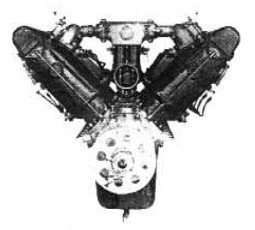
“Model E or I”
-The E's were the same as the I's except that they rotated at more revolutions and had a compression ratio of 5.33 instead of 4.72. The I gave a basic power of 180 CV.
-The E-2 had more compression than the E and a more robust construction.
-The F was similar to the D except that it had no provision to mount a weapon on it.

“Hispano Suiza, model F”
-In 1917, the F reached 300 CV. It was intended for large series, but the end of the war limited its production.
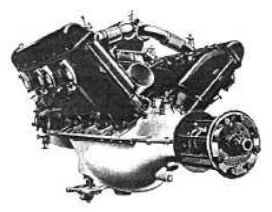
“Model Fb”
-Type 42 was the 8V Fb that gave 310 CV. At first glance, there are few appreciable differences because the improvements were inside.
-The different series A, B, C, D, E, or F vary even in the engine size due to their different cylinder dimensions.
-The Fb had a double Zenith carburetor, two magnetos, two spark plugs, one intake and one exhaust valve per cylinder.
-It was equipped with a Rateau turbocharger.
-The F engine was built in the USA by Wright-Martin as model "H". However the H as such existed in Hispano Suiza.
-The Model H reached 300 CV. It was water-cooled like all V-8s, and had the cylinder banks at 90°.
-It was somewhat larger and used the same construction as the little ones.

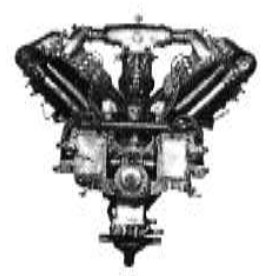
“Model H”
-When they were rotating at 1,800 rpm, the power was 325 CV and at the maximum of 2,200 rpm, the power increased to 375 CV.
-The K models, which had a gearbox, gave 300 CV, and could be fitted with a cannon between the cylinders. The M was an experimental engine that gave 300 CV as well.
-As mentioned, the Hispano-Suiza V-8 was manufactured in several countries by many aviation engine factories.

“Hispano Suiza engines at the Wolseley factory”
-For example, in France they were built by Peugeot, Voisin, Delaunay-Belleville, Doriot-Flaudrin-Parant, DeDion-Bouton, Chenard & Walcker, Fives-Lille, Mayen, Aries, Ballot, Brasier, Scap and Leflavié et Cie. (or Leflaive).
-In Great Britain Wolseley Motors made the Type "A" which was known as 4A Python I with 150 CV. The W4A as Python II with 180 CV.
-Wolseley's 4A with some more compression was the W4A Viper and the geared model was the W4B known as Adder I, II and III.
-In Italy they were made by Scat, Nagliata and Itala. Saurer made them in Switzerland.
-In czarist Russia they were built by National Arsenal.
-And in Japan by Mitsubishi. In Mexico by TNCA.
-We still rescue more V8 engines such as those derived from the H: the H2, He and Se that gave 330 CV, and the G that gave 300 CV. A "Super Fighter" reached 390 CV.
-Some engines based on the V-8, were those that used a single line of cylinders, the same style of 4 cylinders and some used 6 of them. So they have more to do with the 12V. (12-M blocks).

“H-S, model 6Mb, 250 CV” (AEHA)
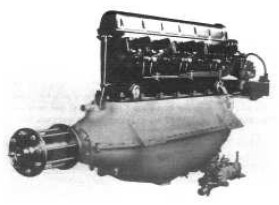
“H-S, model 6Pa, 100 CV” (AEHA)
-They are little known and both have very different sizes as we deduce by their powers.
-These engines escaped the general line that was known from Hispano-Suiza, that is, the 6Ma and 6Mb with 220 CV, and the geared 6MBR with 250 CV.
-The 6O and 6Pa with 100 CV or 120 CV geared. And another one with four cylinders inline, the B-4 that gave 75 CV.
-We see a brochure of Hispano-Suiza in Barcelona, showing their main products.
-First the cover of the brochure with the address in the "Sagrera" street, also known as Ribas road.
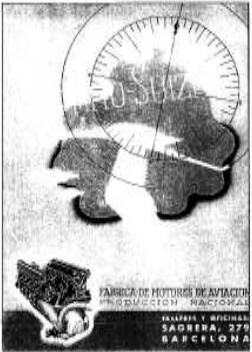
“Brochure cover”
-In the product range, there are the engines that were manufactured at the time. As we can see, they are those that go from 180 to 600 CV.
-By 1923 they began to work on the V-12. Although the engine production was already huge in France, in Barcelona they continued to be built mainly for Spanish aviation.
-At the same time that the V-12 were built, they also made the 12-W and the 18-W.
-Hispano Suiza's V-12 engines began with little power, from 350 CV that was given by the Ja model.

“Product range”
-It is difficult to classify them because there were "type 50", "type 51", "type 52" and between the aviation engines types there were the types of automobile engines following a sequential project order.
-At the same time, to each Type corresponds a specification by number (cylinders) and letters.
-We have seen that the letter "r" refers to reduction gear, the "c" to cannon ", etc.
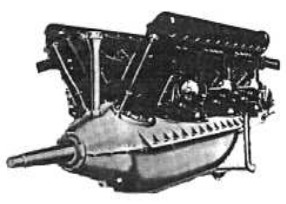
“Model 12-Ja”
-Within Type 52 there is the "Ja" with 350 CV, while the "Jb" increases the power to 400 CV.

“12-Jb”
-The Type 51 were the Ha with 450 CV, of 1927 and the Hb with 520 CV.
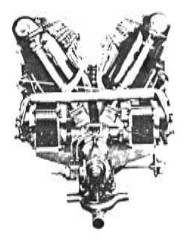
“Ha, Tipo 51”
-The Hbr V-12 was geared and gave a power of 500 CV.
-The type 50 were the Ga with 450 CV. The Gb with 500 CV was the series of engines with 12 cylinders in W, with three rows of cylinders in the shape of this letter.
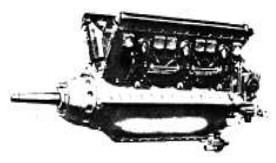
“12-Hbr”
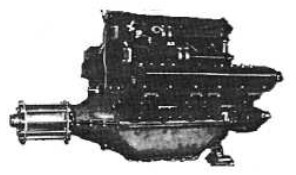
“12-W, model Ga”

“HS 12 Gb, at the MAE warehouse”
-As well as the Kb, giving 600 CV.

“12-Kb”
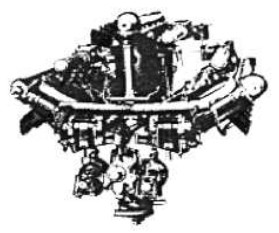
“Another 12 in W, rear view”
-Among the W arrangement engines there were also 18-cylinders with 3 cylinder banks of 6 each.
-The 18R gave 1,680 CV and was installed on the Bernard HV-10.
-By 1929 they made the HS 18R engine that gave 1,600 CV. It was specially made for the Schneider Trophy race.
-Below we show a photo we received from a collaborator.
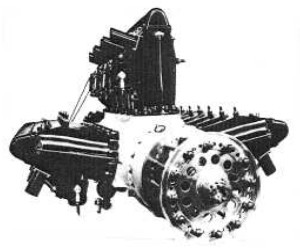
“HS 18R”

“18-W, Sb with banks at 80°”
-And the 18-Sb, more robust but with 1,125 CV, on the Bernard V-4. The Bernards were speed-record airplanes. And there was the Sbr as well.
-Also at the MAE's reserve warehouse, next to a large amount of Hispano Suiza engines of the main types, there is an HS 18 Sb, as we see below.
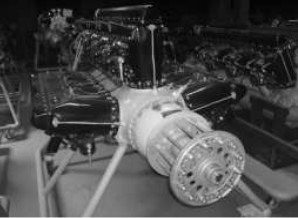
“HS, 18-W, model SB at the MAE”
-Returning to the V-12, the series L, Lb, Lbr were in the 600 CV range. The M, Mbr, with 500 CV. The Mb variant had a Farman-Waseige supercharger. (see Farman). From the year 1933.

“12-Mb”
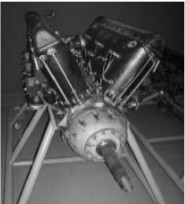
“HS 12V, model 12 Mb, Tipo 57”
-This engine H-S, 12 Mb. Instead of aluminum casting for the different parts, they used "Elektron metal", which is lighter than aluminum.
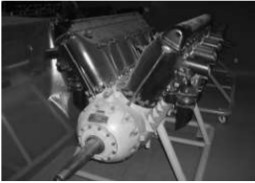
“12-Nb”
-The Nb that gave 720 CV was built in 1928. It had six carburetors, one for every two cylinders.

“Another HS 12-Nb”
-The Nbr was similar with 700 CV, but it had planetary gear.

“12-Nbr”

“12-Xcrs”
-The "X" series engines, such as the 12-Xcrs with gearbox and mechanical supercharger powered the important French Dewoitine D-501 fighter plane during WWII. It delivered 690 CV. It was a cannon-motor.
-To observe well the through-hole of the cannon-motor, the following illustration of an Xbrs with 600 CV is well chosen. You can also see the small front compressor used for starting by compressed air.

“12-Xbrs”
-The starting system by compressed air requires an accumulator boiler and a distributor as if it were a "delco", then some ducts and an automatic valve for each cylinder.

“12-Xcrs”
-The "Y" series has been highly recognized as a result of the experience accumulated in previous V-12 engines.
-The Y-51 illustrated in the above photo gave 1,100 CV of power with a Szydlowski-Planiol supercharger (see Turbomeca).
-Some 600 units of the Y-49 were built in Tarbes.
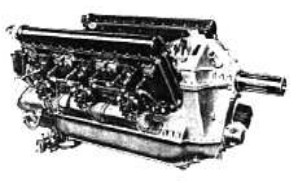
“12Y-31”
-The Y-31 like the one we see in the illustration above has three Solex carburetors per side, with a small front compressor, more visible.
-The Y engines were chosen by V. Klimov to be built in Russia under license and under the M-100 specification and following ones.
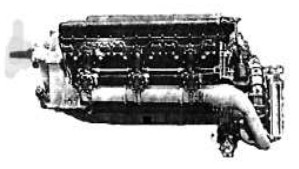
“12-Y-51”
-The "Y-31" gave 860 CV and was mounted, among others, on the Morane Saulnier MS-406.
-The Y-37 gave 920 CV, and the Y-45 delivered 950 CV (on the Dewoitine D-520).
-With the Y-52, the power was raised to 1,250 CV. Basically the engines named 12-Ybrs, Ydrs and Ygrs were in the order of 860 CV.

“12-Ycrs”
-In the illustration above we see the air distributor for starting on the back of the left rocker cover, but it could be mounted indifferently, depending on the model, on the other bank. In this 12-Ycrs we can see very well the cannon-motor version with the breech, together with the controls for the pilot and the loader.

“HS, 12-Ycrs”
-Above we show another Hispano Suiza 12-Ycrs, seen from the side. Here we can see the weapon mount for the 20 mm Oerlikon that was modified by Birkigt.
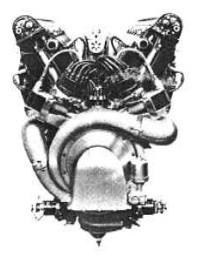
“12-Ybrs”
-The Ybrs that we can see here from behind, is supercharged and without weapon. The engine gives 800 CV at sea level.
-The 12-Ybrg increased its power to 880 CV at sea level, but at an altitude of 2,000 meters it gave 925 CV.
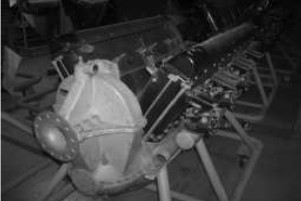
“HS 12Ydrs”
-V-12 Ydrs model engines with gearbox and sometimes the motor-cannon version, have been built under license in many countries. Photograph taken at the MAE.
-We found a photograph of a 12 Y-21, a 12-cylinder Vee-engine with the cylinder banks at 60° giving 890 CV at 2,400 rpm. The maximum of 910 CV at 2,400 rpm but at an altitude of 3,600 meters. The total displacement was 36 liters.

“Hispano Suiza 12Y-21” (photo AEHA)
-Really beautiful is the V-12 engine model Z-89. Actually it is Type 89, and in Spain they were the Z-1 and Z-17, which were used on the first series of Messerschmitt Me-109 aircraft, manufactured under license by Hispano-Aviación in Sevilla.
-As we know, and due to the results, they chose the Merlin that became affordable, giving rise to the "Buchón" plane.
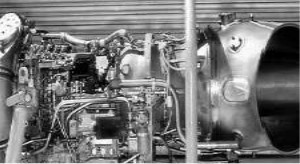
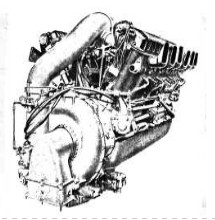
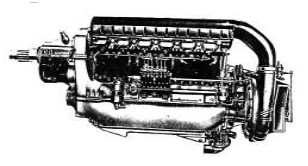
“Three 12-Z views”
-The 12-Z is really nice, with gasoline injection system consisting of two Lavalette fuel injection pumps, one for each cylinder block.
-It had a mechanical supercharger and delivered around 1,800 CV. With a turbocharger it is named 12-ZT, giving the same power of 1,800 CV. This engine was manufactured in Barcelona.
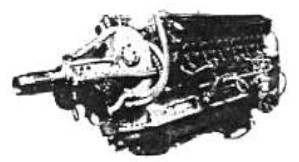
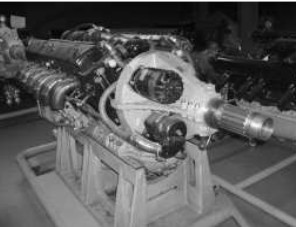
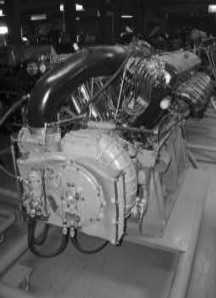
“Some more views of the compact 12-Z”
-There was a project that was cut off by WWII. This was the 12-B engine, but it was continued to be developed after 1945. Some consider it Hispano Suiza's last V-12 project. It had an output power of 2,200 CV with turbocharger and direct fuel injection into the cylinders during the admission stroke. It worked from 1948.
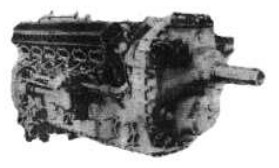
“H-S, 12-B engine”
-The 12-B (it was started with the letter B again after exhausting the alphabet with the 12-Z). It had another version theoretically studied in Barcelona, as on the American P-47 Thunderbolt that had a turbocharger installed behind the cockpit later. It had an intercooler with the necessary ducts and controls, as we see in the figure below from the Pegasus Historical Center.
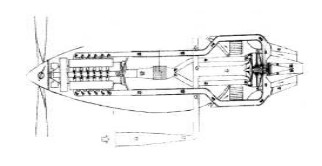
“Turbocharger system”
-The air was taken from the leading edges of the wings, near the roots with the fuselage, on both sides. It was compressed in the turbocharger compressor, driven by the exhaust gases that came from the front engine.
-From the compressor, the air flowed into an intercooler that cooled it to increase its weight and density, and prepared it for its entry into the engine.
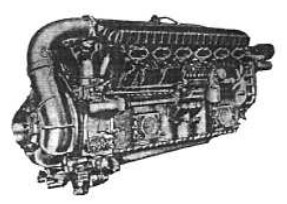
“Another 12-B, with supercharger”
-Among the projects carried out with V-12 engines, throughout its manufacture and little known at the same time, there is one similar to the one carried out by Daimler Benz, placing a 12-Xirs with 690 CV in the fuselage driving a three-stage compressor that supercharged the aircraft's two main engines, the HS 12-Y- 32 and -33, with their 995 CV maintained at high altitudes.
-The design of tandem engines was already done with two 200 CV V-8 engines, giving 400 CV in total.

“V-8 tandem assembly” (Arch. Wifredo Ricart)
-Another double V-12 engine assembly in tandem, but separated one behind the other and with the drive output joined by a Vernisse transmission for contra-rotating propellers, was the one that was mounted on the Arsenal VB-10 plane, (see Arsenal).
-The engines with cylinders in H were also subject to adaptations in Arsenal. But of those built at Hispano Suiza in France the 24-H whose first engine was started in 1938, attracts our attention.

“H-S, 24-H engine”
-With a normal supercharger it reached 3,000 CV. Then with two 2-speed superchargers cross-mounted at the rear, like the Daimler-Benz, the new 24 Z would reach 4,000 CV.
-In the warehouse at the Air and Space Museum there is a 24-Z and its size impresses.
-But it remained at 3,550 CV. They had 4 banks of 12-Z engine cylinders.

“24-Z, more powerful”
-It had output shafts for contra-rotating propellers through gearboxes.
-In fact, it was in direct competition with the Arsenal Diesel 24-H engines that were based on the Junkers Jumo-213 cylinders, "recovered" from the Germans.

“Another view of the 24-Z”

“24 Z, photo at the MAE”
-The frontal gearbox not only joins the powers from the two crankshafts, but also distributes the rotations to the two contra-rotating propellers.
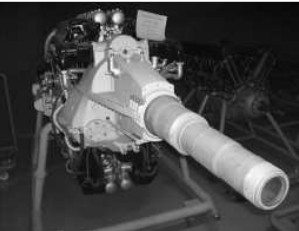
“El mismo 24Z del MAE”
-And now we introduce ourselves in the production of this brand's radial engines. Towards 1929 they manufactured the 170 CV, 5-cylinder Wright R-540 under license, and this engine was known as the HS-5Q.
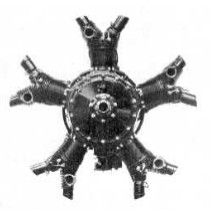
“Hispano Suiza 5Q”
-The R-540 that was mentioned in previous editions of this AtoZ edition, is now provided. Under Wright license giving 180 CV at 2,000 rpm.
-They also made the 16-liter, 9-cylinder R-975. and the 30 l, 14-cylinder R-1820 Cyclone, both under Wright license. At Hispano Suiza they received the specification of model 9Q (Qr, Qa, Qd, etc.). They gave 250 CV.
-The 9-V (Vbs, Vbrs, etc) gave 720 CV.

“9-Qd, at the Cuatro Vientos Museum”

“9-Qdr”

“9-Qa”
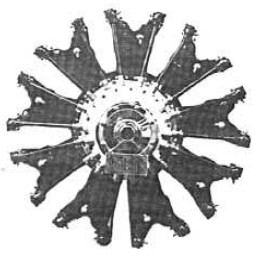
“9-V”
-Hispano Suiza also manufactured the Clerget 9-T and 14-D that became known as 9-U with 300 CV and the 14-U with 540 CV respectively.
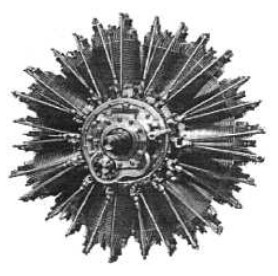
“14-U”
-The -U together with the -T models were diesel or heavy oil engines. They were licensed by Clerget.
-Not all diesel engines did enter into production.
-With two 7-cylinder engines they developed the 14-Ha with 1,000 CV that obtained the final designation of 14-AA.

“14-AA”
-Another and smaller version of this engine without gear, was the 14-AB model from 1936 that gave 720 CV.
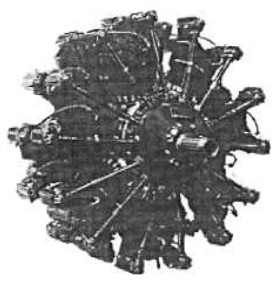
“14-AB”
-The 79-00 type looks like the 14AB, but the latest reference available with supercharger gives 940 CV at 2,100 rpm and 1,000 CV at 2,100 rpm and at 1,550 meters of altitude.

“Hispano Suiza, 79-00”
-After the Spanish Civil War, the main part of Hispano Suiza engines leaves Barcelona. In Barcelona they only kept building the engines for the Spanish Me-109, mentioned above.
-It is dedicated to the construction of trucks, like the well-known Hispano Suiza (later Pegaso) "Mofletes" model that was of truly artisanal construction: the driver's cabin was made by hand and externally "tinned" to cover irregularities before painting.
-Finally the factory becomes INI in a forced sale, like ENASA (Empresa Nacional de Autocamiones SA) where trucks would be manufactured as well as the sensational Z-102 Pegaso sports cars.
-The Barcelona factory was building HS-12-Z engines until the 1950s. These engines were destined for the said Spanish version of the Me-109 aircraft, which were being built at Hispano-Aviación in Seville.
-For the Pegaso Barajas truck model, they started a production line at a factory in Madrid.
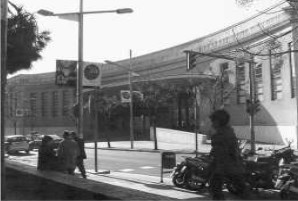
“The old Hispano-Suiza/ENASA”

“Pegaso Park gardens”
-Today at the place of Hispano-Suiza in La Sagrera, Barcelona, there is a nice park with gardens.
-Meanwhile, the French Hispano-Suiza had entered the jet propulsion era, acquiring licenses for Rolls-Royce engines.
-But first, a small clause: There was a study on ramjets with one included in an aircraft, that is, the body of the ramjet was part of the fuselage.
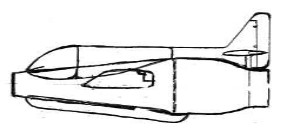
“Hispano-Suiza ramjet”
-It is suspiciously similar to the Skoda-Kauba P-14-01. It is shown below as a reference, without knowing who was the first designer.
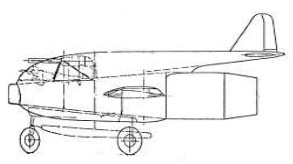
“Skoda ramjet”
-The first turbojets were developed from the Rolls-Royce "Nene" (see), the "Tay" and the "Avon".
-The Nene engines that they manufactured had first the HS-102 indications. (1,760 lb. of thrust). The version 102-A and version 102-B.
-The HS-104, -A, -B, -BR, -C, -D had elektron-cast crankcases.
-The 104-BR model indicates that it has an afterburner designed by Hispano Suiza itself. It was destined for the Mistral aircraft. The axial R-104 was called "Vulcain". Do not confuse R-104 with HS-104.

“HS 102-A exhibited at the MAE”
-Another exposed engine in the CAEA (Air and Space Conservatory of the Air Force) collection, is the Hispano Suiza 102C, still known as Nene in France and made under license from Rolls-Royce.
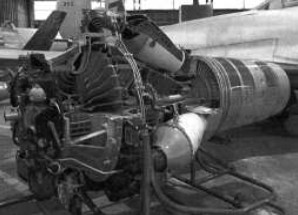
“HS 102C, at the CAEA” (PiP)
-In the engine stock at the Air and Space Museum in Paris (MAE) we can admire a HS-104 still awaiting restoration for its exhibition.

“HS-105-AR”
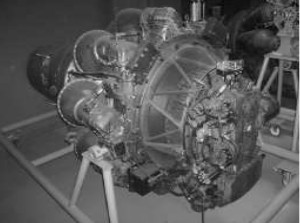
“HS-105, at thel MAE”
-The HS-106 is considered a transfer between 104 and 105.
-The HS-250 and HS-250-A were a design from the Rolls-Royce "Tay", being in turn a development of the Nene. They were very similar but the Tay had more air flow, about a third more and it delivered 5,100 lbf of thrust.
-They were installed on some Mystére, the II and IVA.
-Below we provide a photograph of an HS-250 and another one of a HS-253A exhibited at the CAEA, together with two diagrams of them.

“HS-250”
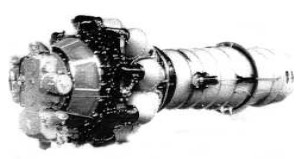
“HS-250R”
-At the Air and Space Conservatory of the Air Force of Aquitaine (CAEA) there is a Hispano Suiza 253A classified as "Verdon", which is exposed although without the rear nozzle.
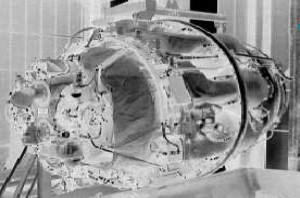
“HS 253A” (PiP)
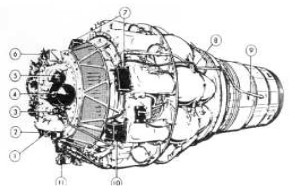
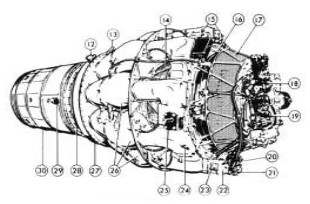
"Two IPC views for the above mentioned engine"
-The R-300 used 90% of parts from the Nene, with 5,940 lbf of thrust.
-The "Verdon" (HS-350) from 1953, is already a development of the previous one and with greater air flow than the Tay. The thrust of the HS-350 went up to 7,700 lbf.

“Verdon, HS-350”
-The-350, for its dimensions and anchors, could be interchanged with the Tay.
-The HS-401 was a derivative from the Nene-105AR with afterburner.
-The R-450 version with 7,720 lbf, was very similar to the HS-350 and the Tay. It flew in a Mystére in 1953.
In 1954, and for the French tactical fighter "Etendard II" project, the R-800 engine came out. It had an axial compressor unlike the centrifugal ones of the previous engines.
-The engine is very light and not too big for 2,640 lbf (1,200 Kgf) of thrust, reaching 4,400 lbf with afterburner.

“R-800”
-Hispano Suiza saw its R-800 engine built in Spain but by INI and with the denomination of INI-12 and nicknamed "Aries". It was destined for the supersonic Ha-300 fighter. It gave 1,400 Kgf of thrust in the tests that were carried out at INTA.
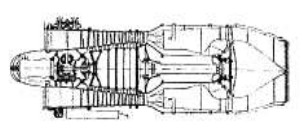
“HS-804”
-The R-800 engine had later versions such as the R-804 with 1,500 Kgf and the R-854 with 2,200 Kgf, The improvements were obtained by internal developments because externally they seemed to be the same.
-The 1,500 Kgf of the R-804 were obtained at 12,000 rpm, with the possibility of using afterburner.
-It has a slightly larger entry cone, and it has an electric starter inside.
-The transmissions for the accessories, oil pumps, fuel controls, tachometers, etc., are placed on the outside, preferably underneath. The mechanical transmission shafts go through the "islands" or the front-cone's streamlined supports, just in front of the compressor, for being a single-shaft turbojet engine. It has a longitude of 3.7 m with afterburner.
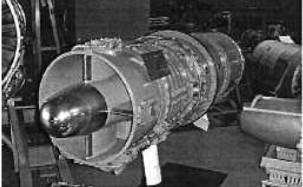
“HS, R-804 at the MAE”
-The licenses to manufacture the "Tyne" 21 and 22 turboprop engines were also purchased from Rolls-Royce. They were destined for the Breguet patrol aircraft, the "Atlantic" and the "Transall" transport aircraft, but in the manufacture RR, MAN (MTU) and FN took also part.
-Assembly and tests were done by Hispano-Suiza.
-The RR "Avon" (RA-7 and RA-16) were manufactured for the Mystere IV-B and for the Caravelle 210 of Air France, respectively.
-At the beginning of the 1960's, under the SEP contract, they made the SEPR-66 and SEPR-844 engines. The latter were "boosters" for the Mirage III. (see SEP and SEPR).
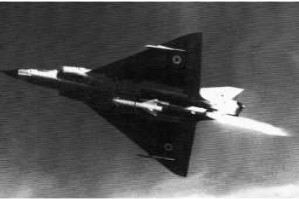
“HS/SEPR-844”
-Hispano-Suiza has serviced and repaired engines of other brands such as GE, CF-700 and CJ-610.
-Finally, it builds accessories and very particularly landing gear in association with Messier, known as Messier-Hispano.
From Appendix 6: Finally the author has come to the conclusion that outside of Spain the word "Hispano" is not related to Spain and less to Barcelona, ignoring the roots of the brand. In France and the USA some writings omit that it was a Spanish company.
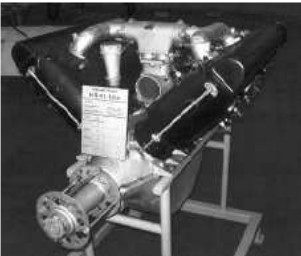
“HS41 - 8Aa”
-The V8 model HS-41 in version 8Aa we can see now after another visit to museums in Europe.
-The picture above is one of the engine itself and the one below an on board installation, with details of the facilities.
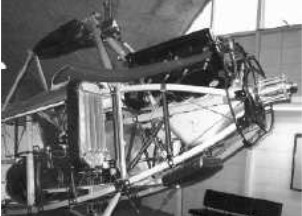
“HS41 - 8Aa, de 150 CV”
-In a Museum in Switzerland, the HS-57 or V12 Mb that gave 500 CV and exposed with its own propeller.

“HS57 - 12Mb”

“HS61 - 12Nb”
-Very interesting has been the exhibition of a 12Y51 (HS77) sectioned at a high level where we can see the cylinder block in detail, uncovered sleeves, pistons and rods.
-Other cut-outs in accessories and gearbox show us more details.
-It gave 1000 CV and was supercharged.
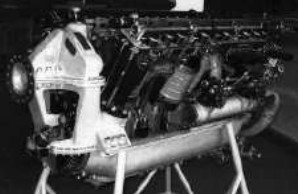
“HS77 - 12Y51”
-We can see a FM-K38 cannon installed upon the same engine. First a rear view of this new HS77 -12Y51. See the cannon breech.
-The two Scintilla magnetos are clearly to be seen with the generating part, rotor and magnetos, and the distributing part at 90° with its twelve high voltage outputs, each of the magnetos to produce the double ignition.

“HS77 with cannon between the cylinder banks”
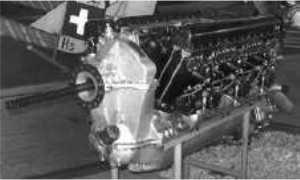
“Cannon sticking out on the above HS77”
- These 12Y51 engines were installed on the Swiss D-3501 and C-3603 aircraft.
-Now we have a photograph of a Hispano-Suiza V8, possibly Martin-Wright, in which we clearly see a "small launch magneto" between the two magnetos used for starting.
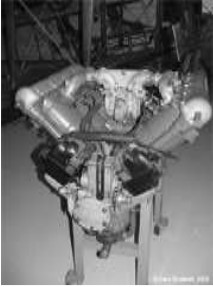
“HS V8, rear view” (Foto via AEHS)
-By pushing the manual crank to engage with the crankshaft a pinion is also coupled to this small magneto that rotates 5 times more to produce an extra current that is sent to the main magneto coils.
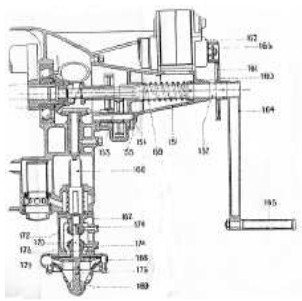
“Starting device HS 140 CV”
-In this example, the crank is in the extension of the crankshaft and in the photo above at 90°. A spring withdraws the handle and decouples it from the crankshaft and the small magneto.
-There is a variant of this engine in H that is known as Type 82, and is exposed at the Polish Air Museum in Krakow.

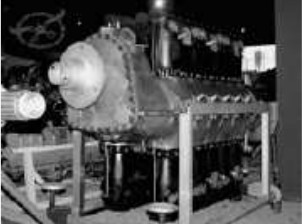
“Two views for the Hispano Suiza Type 82”

“Type 90 at the 1938 Paris Air Show”
-Type 90 had a three-speed supercharger to maintain power up to 10,000 feet.
-The 200 CV, 9-cylinder radial type really gave 225 CV at 1,800 rpm. It was an engine that used heavy oil, that is, Diesel. Influenced by Clerget.

“Hispano-Suiza, Diesel”
-Hispano-Suiza also made the 18L from Gnome-Rhone with Diesel system. See main text. The injection pumps were on the camshaft, between the actuating valve rods.
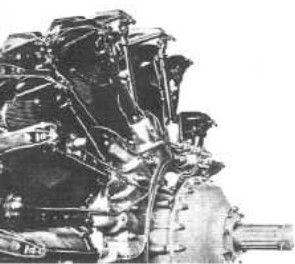
"Detail of the individual injection pumps"
-In the main text the Hispano-Suiza 14-cylinder radial model 14-AB is mentioned but not shown. We present it below.

“The 14- AB, 670 CV”
-Below a drawing of the R-450 Verdon that is mentioned in the main text but from which there was no illustration.

“Verdon R-450”
-With afterburner it gave 9,920 lbf. of thrust at 11,100 rpm and its maximum basic power without it was 7,720 lbf.
-Making a retrospective to the year 1915, Hispano Suiza began its construction of aeronautical engines in Barcelona, as expressed in the main text.
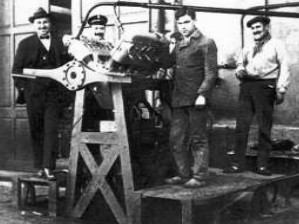
“Birkigt with staff on a bench at the La Sagrera factory”
-There were seven prototype engines of the famous V8, known as T-31 models. Before, a four-cylinder block was successfully tested. The first ones, with serial numbers 3742 and 3743 were taken by the French military Martin Lagarde on his trip to Barcelona. The 3744 was sent immediately.
-The serial number 3744 began with mixed cooling with the upper half of the cylinder cooled by water, and 11 air cooling fins at the lower part.
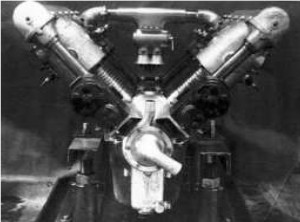
“The 3744 with 11 cooling fins at the lower part”
-The next engine, with serial number 3745, would increase the water-cooling and reduce the air-cooling fins to 8 per cylinder. The problem was piston seizure. With this modification and the alloy change for the pistons, it was solved.
-This engine is now exposed at the Le Bourget Air Museum, near Paris.
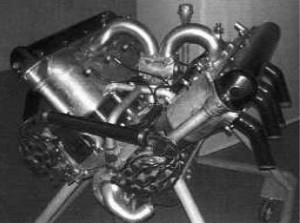
“The 3745 at the MAE”
-The 3746 engine was delivered to the Chalais Meudon test center for trying it out with the intention to get it adopted by the French government. These test were passed very well.
-The 3747 was sent to Cuatro Vientos to be installed on the Barrón Flecha airplane.
-This engine still survives in the Capetti collection in a basement of the Polytechnic Institute in Turin, together with a large group of aviation engines from WWI to WWII. Something worth visiting. See main text too.
-Another prototype was delivered to the Morane Saulnier factory to test it in a model destined for the Spanish army.
-All the tests were satisfactory. This was serial number 3748.
The 3760 was already made in mass production. At the Cuatro Vientos Museum in Madrid, we can see a sectioned one, possibly for teaching and thanks to that it is still preserved. It was one of the first ones.
-Birkigt, the Swiss engineer at Hispano-Suiza, made several previous designs for the V8 engine, varying the water cavities, the number of fins or valve arrangement.
-We have some examples of these studies:

“Several cylinder types for the V8, possibly in the beginning”
-Among the interesting trials there was the proposal of a double engine in tandem with contra-rotating propellers.

“Two HS V8 in tandem”
-The main text is mostly about the development that Hispano-Suiza had in France. But the production in Barcelona was not negligible.
-Eventually they produced the 12Z-17 and -89 for Hispano Aviation aircraft based on the Me-109-G2. With 1,150 CV of power. One of these engines can be seen at the Cuatro Vientos Museum.
Another one we can admire at the IVECO facilities in Barcelona (heiress of Pegaso-Enasa and Hispano-Suiza) and even another one in the private collection of Josep Castellseguer in Mataró (BCN).
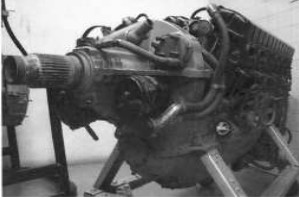

“Two views for the 89 12-Z-17 at IVECO in Barcelona”
At the La Sagrera factory in Barcelona Hispano Suiza produced the V8 engines in several versions. Just as the V12, which they ended with the engine in the above photo.
-They also made the 9 Qd radial engine.
-Another V8 seen at an English Museum (JGB photos).
-It is a 34S, model 6Ab giving 180 CV. The power is clearly to be seen on a rear crankshaft cover.

“Viewing the cylinder banks from the front”
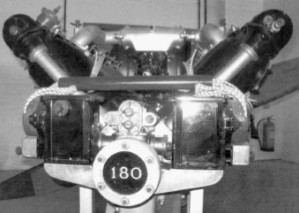
“Viewing the same engine from behind”
-The ignition wires are renewed although "vintage" does not seem "vintage" enough.
-The following is a descriptive table of the aforementioned production.
-Subsequently, Hispano-Suiza was nationalized and renamed ENASA (Empresa Nacional de Autocamiones SA). Later it was sold to Italian IVECO, current holder of the remains of material and resources.
-During the change from Hispano Suiza to Enasa (Pegaso) there was a great industrial engineer, Wifredo Ricart, who came from Alfa Romeo and had experience both in aviation engines and sports cars.
-At Pegaso he made the formidable Z-102 sports car, which was advanced for its time. Wifredo was the founder of the CETA company with Italian staff where unusual engines were designed. And later these engines were made by ENASA-Pegaso.
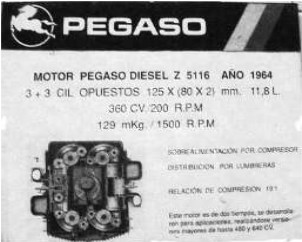
“Strange Z design from Ceta”
-CETA's Z engine by Wifredo is really original, because it is "square", with double pistons in cylinders on both sides and a complicated connecting rod and rocker arm system to drive the central crankshaft.
-It was not an aviation engine but was manufactured at the Hispano Suiza facilities, with means and expert personnel of that great company.
-At the old IVECO facilities they were stored on display stands (and together with other examples of automotive, truck and the 12Z aviation engine) in an impressive perfect conservation aspect, at least from the outside. It is estimated that thirteen engines are cataloged by the Generalitat de Catalunya as a Cultural Asset of Barcelona's Industrial History.
-Production of Hispano Suiza aviation engines in Barcelona, between 1915 and 1952.

-Two photographs from opposite angles of this formidable engine, which is painted in impeccable metallic blue, without bumps or scratches, not even dust, which is to be welcomed.

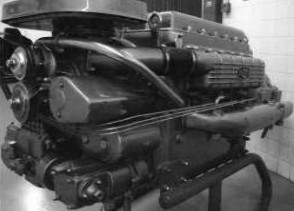
“Two views for the extraordinary CETA engine”
-In an intimate visit to the "Associació D'Estudis Històrics de L'Automoció" made recently I have been given more information about the work carried out at Hispano-Suiza in Barcelona. There was the automobile section and the aviation engine section.
-The general history and the automotive side can be summarized as the AEHA does in its brochure and on the Internet, on its website (www.aeha.tk)
-Along its history there were three emblematic symbols and logos for the brand:
-1st, the winged wheel with the Spanish and Swiss flags.
-2nd, the one of the stork of Guynemer.
-3rd, Pegaso's horse in a circle.

“Symbols of Hispano-Suiza and ENASA-Pegaso”
-In the approximately 70 years of these brands' life there were important milestones such as the Spyder Tipus 15T car, also known as the "Alfonso XIII" between the years 1911 and 1913.
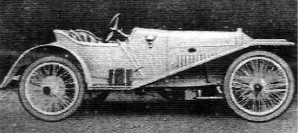
"Baptized Alfonso XIII, in honor of the King of Spain"
-The 15T was considered one of the best sports cars of the "Belle Epoque". It obtained numerous successes in "Voiturettes" races.
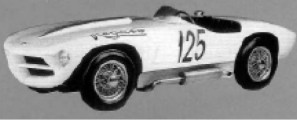
"The fabulous Pegaso Z-102"
-At the end of the active life of Hispano-Suiza in Barcelona when it was nationalized, and already as ENASA-Pegaso, the Z-102 car was made, which was very advanced for its time and not without effort but with propaganda views. This was the work of engineer Wifredo Ricart (see) and his team.
-At the moment that the Hispano Suiza factory was nationalized it had this view from the air.
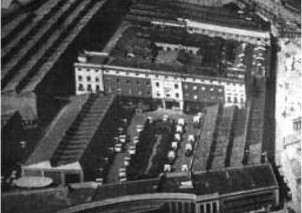
“The Hispano-Suiza factory in La Sagrera in the early 1950’s”
-The production of trucks and coaches continued -in Madrid as well- such as the Barajas model and the 2331, finally in Troner.

“The Pegaso 2331 tractor-unit from the early 1980’s”
-They were built in the new factory in the Zona Franca. The company passed into the hands of Italian IVECO and today in 2010 there are serious doubts about its continuity.
-Returning to the visit to AEHA and in a meeting with an important group of ex-employees I am provided with information that goes beyond the technical interest, although it exists, it is rather of interest for the Hispano Suiza people.
-I am informed about a very important person, but for me unknown until this moment: Head of Workshop, Domingo Anguera Paleato.

“Domingo Anguera”
-He was responsible as "Cap de Taller" (Head of Workshop) for the Hispano Suiza aviation engine tests in Barcelona.
-Domingo Anguera Paleato (1882-1969), a resident of the nearby Sant Andreu neighborhood, joined Hispano Suiza on June 17, 1913 as an adjuster-assembler operator.
-Soon he is assigned to the testing section of automobile engines and when the aviation section is created, he becomes the tester for these new engines.
-He was meticulous in his notes referring to work incidences and facts. At the same time he was self-taught continuously improving his knowledge.
-All of these qualities, accompanied by his intense dedication to work entrusted to him, were soon a reason for recognition by his bosses and by the Company Management.
-The tests with aviation engines were carried out in the open air. With a look at the flames of the exhaust gases and the pick up of an abnormal and insignificant noise Anguera had enough to diagnose and locate any anomaly of the tested engine.
-In the month of May of 1927 he was awarded his first Medal for Merit at Work by General Primo de Rivera at Cuatro Vientos, and in 1963 he was awarded a second medal.
-The majority of the aviation engines that were manufactured at the Hispano-Suiza factories in Barcelona passed through his control for homologations, and of course engines such as those used and prepared to carry out raids, including flights such as those by Jimenez and Iglesias.
-But what calls our attention is the document obtained from the report made on the Type 31 engines, which are shown in the illustrations below, especially the photograph of the 3745 that turned out to be the first operational engine, and this is the one that has been mentioned to be sent to France, reaching our days at the Air and Space Museum in Le Bourget. Perfectly restored.


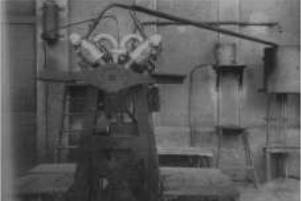
“The 3745 on a bench in Barcelona”
-The 3745 with 8 cooling fins followed the prototypes 3742, 3743 and 3744 that had 11 fins.
-Below we show the report written by Anguera himself in 1915 about -what it seems to be- this engine.
-There was an anecdote about Domingo Anguera. As a reward for his absolute dedication (he did not take vacations or even public holidays) he was rewarded with a trip to Bois-Colombes. There they expected to receive a well-dressed personality but Domingo turned up with worker's clothing and espadrilles, leaving the audience dislocated.
-Domingo Anguera was appointed Workshop Manager in 1941, Workshop Master in August 1946 and Head of Workshop (Cap de Taller) with the company already under ENASA in September 1963.
-Domingo retires on September 30, 1965, providing his last services to the company in ENASA's Experience Section and as the company's the number 1 employee. Everyone at the company knew him in the most affectionate sense as "L'Avi Anguera" (Grandfather Anguera).
-In the two sheets of the report showed above you can see the introduced improvements, the components that were used and characteristics obtained from the engine.
-Throughout his life he made all kinds of reports and as proof of this we provide the Test of Reception for the Hispano-Suiza engine 89-12Z-17, serial number 50020, which was intended for Hispano-Aviación 1109 airplanes -(the Messerschmitt Me-109G-2 manufactured in Seville).
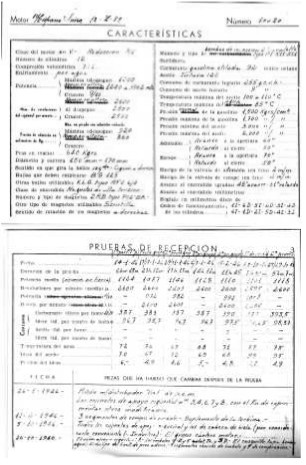
"Test-result sheets handwritten by Anguera himself"
-The 89-12Z-17 engines that were totally made in Barcelona, were tested in the factory before being sent to the structure manufacturer. Do not forget that Hispano-Aviation was a continuation of Hispano-Suiza.

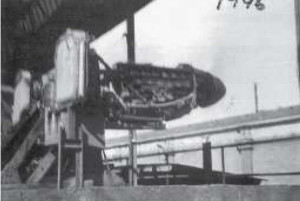
“Two photographs of the 89-12Z-17 test bench”
-In the lower photograph there are two automobile radiators for the refrigerant. We see that it is the year 1946.

"Assembly team for the above mentioned engines"
-This photograph of the Aviation-Section staff was taken on June 15, 1945.
-In it we see from left to right and top to bottom:
Espadalé, Forcada, Eslava, Alio, Cuixé, Blancher, Admirable, Viscasillas, Serdoz, Lerin, Collado, Benavent, Quevedo, Gutierrez, Caballero, Baxó, Aguilera and in front of every one, Lozano.
- Personally, the author of this publication on aviation engines would have been excited to be in this group.
-There is also another photograph of human interest with the staff-team of Hispano-Suiza at Reus Air Base (Fighter School), which includes managers, technicians and operators together with a Messerschmitt on which they installed the new 89-12Z-17 engine. It was in the year 1943.

“At Reus Aerodrome”
-A curiosity: the engines made under Hispano Suiza license in the United States were known as Hisso by contraction of both names. In the 1950's, in a Popsci issue appears a story about a French experimental combat aircraft, the Grognard.
-Curiously this project was advanced by the placement of its two Hispano Suiza Nene turbines on top of each other. A type of installation that the British would carry out with the Lightning from English Electric.

"The Grognard with upper air intakes"
-In the mentioned article it appears that this aircraft had two "HISO-Nene" engines (instead of Hisso, besides). It's by Sncase.
-But the case is that turbojet engines of English origin were built in France under license and not in the USA.
-Therefore the perplexity to see the Hiso engine name related to the Nene.
-And now a view of the Hispano-Suiza factory in Bois-Colombes, France. On the Boulevard Louis Seguin.
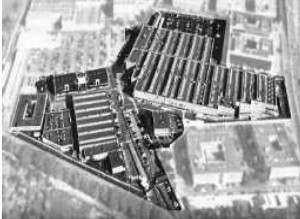
"Aerial view of the Hispano-Suiza factory in France"
-We now can show engines that are explained in the main text but without illustrations.
-They are the 8V Type 44 from the year 1917 with 220 CV. According to the text that accompanied this picture by J.P. Rossignol, the engine did not have the oil pan as a deposit but collected the oil that fell from the engine and sent it to a separate tank by means of an additional pump called "pick-up" or "recovery" pump.

“Hispano-Suiza Type 44”
-Another engine that did not have picture in the main text is the Type 34 (and 34S).
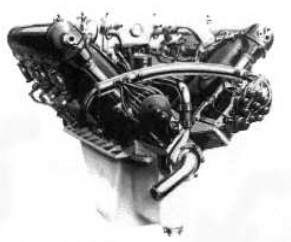
“H-S Type 34/34S, de 150/180 CV”
-From a job due to the same Mr. Rossignol mentioned above is the recovery of this sheet of a H-S Type 36, "cannon" engine.

"Perspective focused on gearbox and weapon"
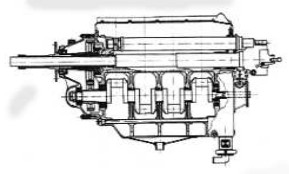
"Clear vision of the weapon in a Type 38"

"Detail of a" dry sump "in Type 44"
-There was a Hispano-Suiza model that was modified for the need for engines in WWI. Many recovered engines were revised to return to their active life.
-At the Bleriot subsidiary in Italy (Transaera) engineer Mr. Albert Triaca eliminated the model 35 gearbox to adapt it to the needs of their aircraft.

"Strange shape of the Triaca"
-The modification was simple; it was also done according to the instructions from Hispano-Suiza: the gearbox was removed and an extension was placed at the front end of the crankshaft.
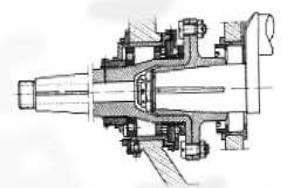
“Extension on the Triaca”
-Information that appeared in the interesting study by J. P. Rossignol on the H-S "Cannon-Motor".
-Now we have a picture of the Wright-Martin model K that could not be published in the main text either.
-The K model was derived from the H of the same American brand (a Hispano-Suiza with 300 CV). It had reducing gear at a rate of 9:13 and could be provided with a cannon in its center.
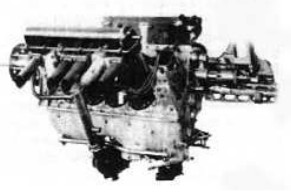
“Wright-Martin, modelo K”
-Interestingly, due to lack of orders there was no mass production.
-From the page "The Vintage Aviation" a photo with a rear view of a V8 with a rare magneto on the left.
-It is mentioned that it belongs to a Bristol SE5a aircraft.

"Photo from New Zealand"
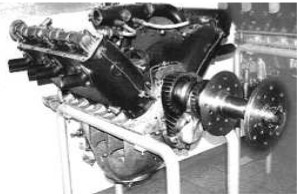
"V8 at the Munich Museum"
-It is sectioned in several areas to show their interior parts in a didactic way.
-It shows the robust form of its components such as camshaft and gearbox.
-We also offer a new picture of the 24-cylinder in H, placing the 6-cylinder banks in this shape. It gave about 2,200 CV at 2,400 rpm.
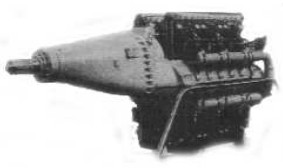
“H-S 24-cylinder in H”
-The Hispano-Suiza model 79, double-row, 14-cylinder, radial engine.
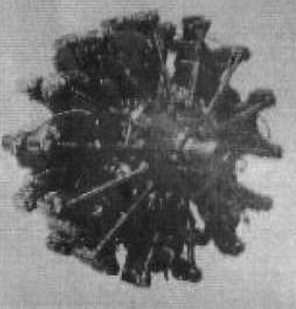
“Radial Hispano Suizo series 79 engine”
-The tests of a new exhaust manifold with the intention of reducing noise without losing power.
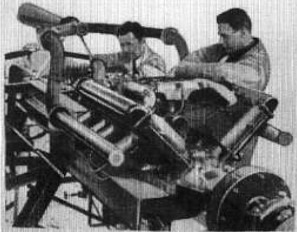
“Special exhaust on a Wright Martin / H-S”
-Disclaimer about a collection of engines of the Hispano-Suiza/Pegaso:
-Finally, to finish off the Hispano-Suiza chapter of this Edition-Version 7: To denounce that returning to old practices used in times of the post-Spanish civil war, the engine collection representative for the production of Hispano-Suiza and Pegaso in Barcelona, composed of about 14 engines, some sectioned and exposed, have been mutilated by unscrupulous characters.
-Five engines have disappeared, the most significant ones of this historic factory's production line. With another engine removed years before, the collection has been destroyed.
-They were duly protected as Historical and Cultural Heritage by the Generalitat de Catalunya and its destination was an Industrial Museum in the City that already has its headquarters in an old factory in zone 22A of Poble Nou in Barcelona.
Two of these engines appear in this publication: the Hispano-Suiza 89-12Z-17 and the CETA Z, an extraordinary engine designed by Wifredo Ricart.
-The feelings of many people who worked in the company and in general of all the people of Barcelona have been aggrieved by this pillage or robbery that occurred at the end of 2010, taking advantage of the difficulties of the current heiress Iveco in the process of selling the facilities to the Comesa-ZF group, with labor conflicts included.
-If it has occurred with high connivance, here we would consider it a lack of loyalty.
-That is to say, they used the disturbance to make them disappear. Everything indicates one person and a few accomplices. There remain 8 automotive engines still in 1Q11.
-Local representatives and the Generalitat understand that they must be returned and are taking actions that in my opinion must be resounding.
-It is material that has been designed and built in Barcelona and if it should be exposed, there is no other place in the world like in this city.
-Later (early 2011) one of the disappeared Pegasus engines have been seen in the reception of Iveco in Madrid (Barajas). Together with another material worthy of mention, such as a Z-102 car, an H-S V-8 engine (photo below) and explanatory panels.

"H-S V8 at the reception of Iveco de Barajas"
(it's the "14" missing engine)
From Appendix 9: Spain/France. On November 8, 2012, I attended a conference on the Hispano-Suiza factory in Barcelona and its collectivization during the civil war from 1936 to 1939.
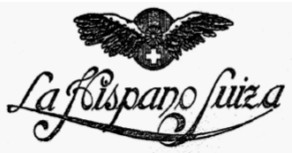
"From a catalog of a brand vehicle"
-At the same time a small book was presented on Hispano-Suiza titled "Summary of its history", written by Josep Casalta Miralles, ex-manager of the La Sagrera factory. He is currently the president of the "Asociación d'Estudis Histórics de l'Automoçió "(AEHA).

"Logo of AEHA that is mentioned above"
-From there comes an interesting picture that is repeated twice in the main text, the HS motor, type 31, with 11 fins, or the first design. We recovered a photo of a V12 with some particular exhausts that was exhibited at the SA Corbetta Stand at the 1937 Milan Show.
-The full name of this representative in Italy was "Societatá Anonima Commerciale Succ.ri G. Corbetta".
-The engine draws attention for its appearance. The gearbox with a shaft that allows it to be used as a "cannon-engine".

“ SA Corbetta stand” (PiP=LBC)”
-In the main text there are two silhouettes giving a size difference between the 300 CV engine and the previous ones.

"Difference between two HS, 150 CV and 300 CV"
-The first V8 A, Ab, Ba, etc. had the cylinders with 120 mm bore (4.72 inches) and 130 mm stroke (5'12 inches), giving a cubic capacity of 11.77 liters or 716.8 cubic inches.
-For the 300 CV engines (ie the V8-F) the bore went to 140 mm and the stroke was longer, 150 mm, with a total displacement of 18.5 liters.
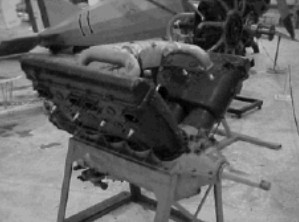
“A 300 CV engine”
-It is distinguished by the cylinders (where the first ones had fins) with the longest neck.
-The compressions started with 4.7: 1 to reach about 5.3: 1 and finally reaching 5.5: 1 with Type 42vs.
-The revolutions to get the powers varied. Even with the use of gear.
-A friend from Madrid has just sent me a photo, unknown to the author until today. It shows a rear view of a Type 34 S. I know that he is making a great article on the subject.
-We see a manual crank at the rear.
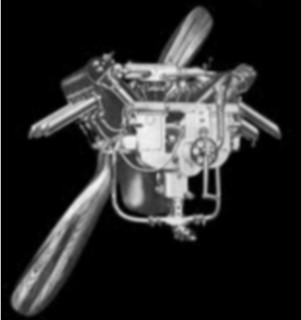
“Hispano-Suiza Type 34 S”
-From collaborator Oscar Alvarado from Mexico we have two Hispano Suiza V8 pictures. Possibly from those received directly from the Barcelona factory, due to a purchase agreement, together with the license and a collection of tools necessary for manufacturing.
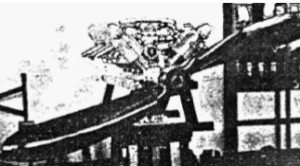
"A 150 CV HS V8 with special native propeller"
-This photograph is taken from Tohtli magazine. Mexican aeronautical magazine from the early days of aviation, until approximately 1922.
-The propeller that we see was called "Potential Helix" special for this engine.
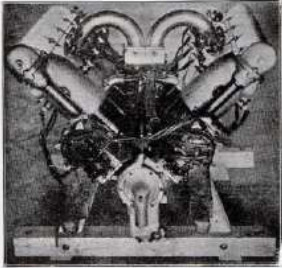
"Another photo of the HS V8 engine in Mexico"
-First they received 2 engines but it is mentioned that there were some more.
From Appendix 10: We are still in the centennial year of the first H-S V-8 operation that was so significant in WWI.
- I just got to know one of these engines at the Technical School in Prague in Czechoslovakia.

"A good didactic example"
-And another issue is reported in the blog "Aerospace engines. blogspot.com " by the author.
There I indicate that, among others, the engine that is in the showroom at the "Museo Argentino de Aviación" still has the carburetor at the upper part of the engine instead at the lower part where it should be.
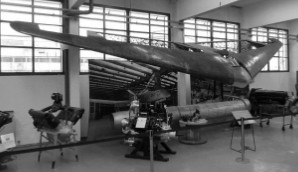
"On the left the V-8 in Moron, Argentina"
-Positioned above, the carburetor remains with the intake facing backwards. Inconceivable.
-As a curiosity we bring two brand logos used in different times. The most common has always been that of the winged rotor with the Spanish and Swiss flag.

"Two alternative logos used by Hispano Suiza"
-Plan of the famous V8 "Cannon-Motor".

“Cannon-Motor, type 35” (via Museo SAFRAN)
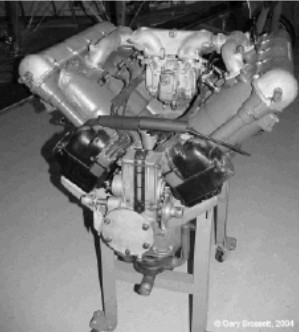
"HS V8 made by Wright in the USA" (AEHS)
-This picture is brought back here because the detail of the starter crank is showed. Its coupling enters the rear accessory box.
-But before, a gear of more diameter drives another small one that belongs to a small "launch magneto".
-This is the square box fastened with a cinch around it. There it generates a current that feeds the distributor of one or both magnetos, with delay to avoid backward movements of the propeller.
-When turning the crank the engine does not rotate at the sufficient speed so that the main magnetos can start the engine.
-Once the engine is started and the crank is stopped, it is disconnected from the crankshaft and the small generator also stops working.
-The engine known as 24H was for its architecture of 24 cylinders in H position, for its four blocks from a 12 V, being in fact the Type 82.

“Hispano-Suiza 24 in H”
-By the shape of the blocks, possibly they were from the "Y"

"Rear view of the engine with supercharger"
-The shape of the cylinder covers are more like the HS V-12 from before the 24 Z with 3,600 CV.
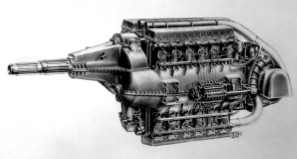
"The 24Z with 24 cylinders in H, and blocks of 12V-Z"
-It is easy to confuse a Hispano-Suiza 24H with an Arsenal 24H at first sight. Those of Arsenal have blocks of Jumo 213 cylinders, confiscated from the Germans.
-Another known 24H engine of Hispano is composed of four banks of 6 cylinders arranged in "H". As these are from the V12 model Y engines, they are known as the 24Y-Type 82. They have a single propeller.
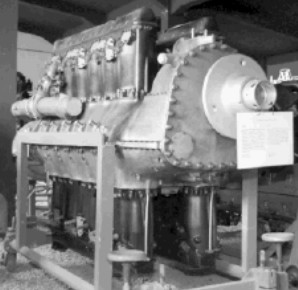
"Clearly the blocks are from a V12Y"
-However, the 24 H engine model with most possibilities was the 24Z

"The compact and powerful 24Z"
-They had two contra-rotating propellers, it was intended for a SE-580 aircraft that we see in the photo below. With exhausts at the top and bottom on each side.
-It was derivated from the SE-540, it was surpassed by the jets.

"The advanced model SE-580"
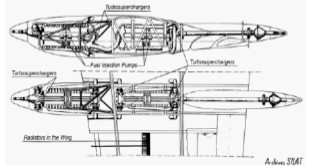
"Project with HS 48Z"
-Clearly an assembly of two 24Z in tandem in the bow and some turbochargers in the center of the fuselage driven by the exhaust gases of the main engines.
-It is a SILAT project and taken from their archives. The transmission to the tail of the plane is strange. (Or exhaust outlet?).
-The author is investigating if any construction of this plane was carried out. SILAT are the initials of the "Société Industrielle d'Aviones Latecoére" and the closest thing is the model 299 of two tandem Hispano Suiza engines, but two versions are mentioned:
-One with two engines in tandem 12Y-43 (see H-S) and the other with two engines 12Z-17.
-Therefore, the one that uses 48Z engines (Type 96) is from later in this development line.
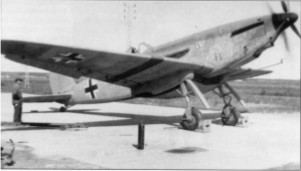
"Photo of a 299, after the German occupation"
From Appendix 12: Especially in France the V8 engines built during the WWI had a cannon installed between the V formed by the two cylinder banks.

"V8 engine with a weapon going through the gearbox"
-Due to the installation of the cannon the updraft carburetor had to rise and the collectors take the shape that we see in the photo of an engine seen in a Museum.
-We saw these engines installed on the famous SPAD XIII that together with two synchronized machine guns made it a lethal aircraft with which the air domain was achieved.
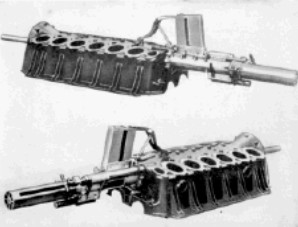
"Two views of an H-S V-12 with a Puteaux cannon"
-The impressive weapon goes through the engine, peeking through the center of the high gearbox position. The gearbox is not installed. On top we see the bullet magazine.

"V8 test bench in Bois-Colombes" (Ecpad)
-Exposed at the Paris Air Show, the radial 14 A2S with 1,000CV.
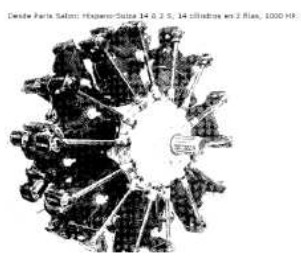
"HS double row 14-cylinder radial giving 1,000 CV"
-The Hispano Suiza 9-cylinder under Clerget license ran on Diesel.

“9- cylinder Hispano-Suiza, 575/650 CV”
-Now a curiosity. In the V-12 engines the injection or mixture supply was done in unusual points.
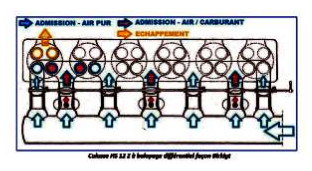
“V12-Z engine with four valves per cylinder”
-The mixture is supplied to two adjacent cylinders at the same time but only through one of the valves, through the other one only air flows in.

"In the Russian VK-107 (Lic HS) the system is the same"
-Even with the valve arrangement in the cylinder head in different positions, the air/gasoline supply is maintained through only one valve, with air only in the other.
-A curious system that we bring to collation for being a very interesting detail. (Provided by a contributor from a French publication PiP).
Engines of HISPANO SUIZA
Model: .”Triaca”, modificacion V8
Arquitecture:
Cooling:
Total Displacement:
Bore / Stroke: x
Power:
Weight:
Model: 102-A, -B, -C (RR Nene Lic.)
Arquitecture:
Compressor/s:
Combustion chambers:
Turbines:
Power / Thrust: / ---
Weight:

"Hispano Suiza, 102-A exhibited at the MAE"
Model: 104A, -B, -BR, -C, -D
Arquitecture:
Compressor/s:
Combustion chambers:
Turbines:
Power / Thrust:
Weight:
Model: 105, -AR
Arquitecture:
Compressor/s:
Combustion chambers:
Turbines:
Power / Thrust: / ---
Weight:

"Hispano Suiza, 105-AR"
Model: 106
Arquitecture:
Compressor/s:
Combustion chambers:
Turbines:
Power / Thrust: / ---
Weight:
Model: 12-G, -Ga, Gb (W12)
Arquitecture: 12-cylinder W-engine
Cooling: Liquid
Total Displacement:
Bore / Stroke:
Power: 450 CV
Weight:
Power per model:
Ga: 450 CV
Gb: 500 CV

"Hispano Suiza, 12-W, model Ga"
Model: 12-K, -Kb, -Kbrs
Arquitecture: 12-cylinder W-engine
Cooling: Liquid
Total Displacement:
Bore / Stroke:
Power: 600 CV
Weight:

"Hispano Suiza, 12-Kb"
Model: 14-AB
Arquitecture: 14-cylinder Radial
Cooling:
Total Displacement:
Bore / Stroke:
Power: 720 CV
Weight:

"Hispano Suiza, 14-AB"
Model: 14-D
Arquitecture: 14-cylinder Radial
Cooling: Air
Total Displacement:
Bore / Stroke:
Power: 540 CV
Weight:
Model: 14-H, -Ha, -Hbrs (14-AA)
Arquitecture: 14-cylinder Radial
Cooling:
Total Displacement:
Bore / Stroke:
Power: 1000 CV
Weight:

"Hispano Suiza, 14-AA"
Model: 14-U
Arquitecture:
Cooling:
Total Displacement:
Bore / Stroke: x
Power:
Weight:

"Hispano Suiza, 14-U"
Model: 18-R (W18)
Arquitecture: 18-cylinder W-engine
Cooling: Liquid
Total Displacement:
Bore / Stroke:
Power: 1600 CV
Weight:

"Hispano Suiza, 18R"
Model: 18-S, -Sb, -Sbr
Arquitecture: 18-cylinder W-engine
Cooling: Liquid
Total Displacement:
Bore / Stroke:
Power: 1125 CV
Weight:

"Hispano Suiza, 18-W, Sb with banks at 80 degrees"
Model: 24-H (Type 82)
Arquitecture: 24-cylinder H-Engine
Cooling: Liquid
Total Displacement:
Bore / Stroke:
Power: 3000 CV
Weight:

"Hispano Suiza, 24-H"
Model: 24-Y
Arquitecture:
Cooling:
Total Displacement:
Bore / Stroke: x
Power:
Weight:
Model: 24-Z
Arquitecture: 24-cylinder H-Engine
Cooling: Liquid
Total Displacement:
Bore / Stroke:
Power: 3550 CV
Weight:

"Hispano Suiza, 24-Z"
Model: 250-A, -R. (RR-Tay Lic.)
Arquitecture:
Compressor/s:
Combustion chambers:
Turbines:
Power / Thrust: / ---
Weight:

"Hispano Suiza, 250R"
Model: 253-A, Verdon (Lic. RR)
Arquitecture:
Compressor/s:
Combustion chambers:
Turbines:
Power / Thrust: / ---
Weight:
Model: 350
Arquitecture:
Compressor/s:
Combustion chambers:
Turbines:
Power / Thrust: / ---
Weight:

"Hispano Suiza, 350"
Model: 36-Y (Latécoère)
Arquitecture:
Cooling:
Total Displacement:
Bore / Stroke: x
Power:
Weight:
Model: 401-A
Arquitecture:
Compressor/s:
Combustion chambers:
Turbines:
Power / Thrust: / ---
Weight:
Model: 450
Arquitecture:
Compressor/s:
Combustion chambers:
Turbines:
Power / Thrust: / ---
Weight:
Model: 48-H
Arquitecture:
Cooling:
Total Displacement:
Bore / Stroke: x
Power:
Weight:
Model: 48-Z (Type 96)
Arquitecture:
Cooling:
Total Displacement:
Bore / Stroke: x
Power:
Weight:
Model: 5Q (R-540)
Arquitecture: 5-cylinder Radial
Cooling: Air
Total Displacement: 540 cu. in.
Bore / Stroke: 127 x 140 mm
Power: 180 CV @ 2000 rpm
Weight: 191 Kg

"Hispano Suiza 5Q"
Model: 6-M, -Ma, -Mb, -Mbr
Arquitecture: 6-cylinder In-line
Cooling:
Total Displacement:
Bore / Stroke:
Power: 220 CV
Weight:
Power per model:
6Ma, 6Mb: 220 CV
6Mbr: 250 CV

"Hispano Suiza, model 6Mb, 250 CV"
Model: 6-O, 100 HP
Arquitecture: 6-cylinder In line inverted
Cooling:
Total Displacement:
Bore / Stroke:
Power: 100 CV
Weight:
Model: 6-P, -Pa
Arquitecture: 6-cylinder In-line
Cooling:
Total Displacement:
Bore / Stroke:
Power: 120 CV
Weight:

"Hispano Suiza, model 6Pa, 100 CV"
Model: 9Q (Wright Whirldwind, Lic.)
Arquitecture: Radial
Cooling:
Total Displacement: 16 Ltr.
Bore / Stroke:
Power: 250 CV
Weight:

"Hispano Suiza, 9-Qa"
Model: 9T, Diesel
Arquitecture: 9-cylinder Radial
Cooling: Air
Total Displacement:
Bore / Stroke:
Power: 300 CV
Weight:
Model: 9V (Wright Cyclone, Lic.)
Arquitecture: 9-cylinder Radial
Cooling:
Total Displacement:
Bore / Stroke:
Power: 720 CV
Weight:

"Hispano Suiza, 9-V"
Model: Avon (RR Lic.)
Arquitecture:
Compressor/s:
Combustion chambers:
Turbines:
Power / Thrust: / ---
Weight:
Model: B4, 75 HP
Arquitecture: 4-cylinder In-line
Cooling:
Total Displacement:
Bore / Stroke:
Power: 75 CV
Weight:
Model: R-300
Arquitecture:
Compressor/s:
Combustion chambers:
Turbines:
Power / Thrust: / ---
Weight:
Model: R-800
Arquitecture:
Compressor/s:
Combustion chambers:
Turbines:
Power / Thrust: / ---
Weight:

"Hispano Suiza, R-800"
Model: R-804
Arquitecture:
Compressor/s:
Combustion chambers:
Turbines:
Power / Thrust: / ---
Weight:

"Hispano Suiza, R-804 at the MAE"
Model: R-854
Arquitecture:
Compressor/s:
Combustion chambers:
Turbines:
Power / Thrust: / ---
Weight:
Model: Tyne (RR Lic.) + otros fabr.
Arquitecture:
Compressor/s:
Combustion chambers:
Turbines:
Power / Thrust: / ---
Weight:
Model: V12-B
Arquitecture: 12-cylinder V-Engine
Cooling: Liquid
Total Displacement:
Bore / Stroke:
Power: 2200 CV @ rpm
Weight:

"Hispano Suiza, 12-B, with supercharger"
Model: V12-H, -Ha, -Hb, -Hbr
Arquitecture: 12-cylinder V-Engine
Cooling: Liquid
Total Displacement:
Bore / Stroke:
Power: 450 CV
Weight:
Power per model:
Ha: 450 CV
Hb: 520 CV
Hbr: 500 CV

"Hispano Suiza, 12-Hbr"
Model: V12-J, -Ja, -Jb
Arquitecture: 12-cylinder V-Engine
Cooling: Liquid
Total Displacement:
Bore / Stroke:
Power: 350 CV
Weight:
Power per model:
J, Ja: 350 CV
Jb: 400 CV

"Hispano Suiza, Model 12-Ja"
Model: V12-L, -Lb, -Lbr, -12Lbrs
Arquitecture: 12-cylinder V-Engine
Cooling: Liquid
Total Displacement:
Bore / Stroke:
Power: 600 CV
Weight:
Model: V12-M, -Mb, -Mc
Arquitecture: 12-cylinder V-Engine
Cooling: Liquid
Total Displacement:
Bore / Stroke: 130 x 170 mm
Power: 500 CV @ 2000 rpm
Weight: 455 Kg

"Hispano Suiza, 12-Mb"
Model: V12-N, -Nb, -Nbr
Arquitecture: 12-cylinder V-Engine
Cooling:
Total Displacement: 36 Ltr.
Bore / Stroke: 150 x 170 mm
Power: 720 CV @ 2000 rpm
Weight: 520 Kg
Power per model:
Nb: 720 CV
Nbr: 700 CV

"Hispano Suiza, 12-Nb fig.2"
Model: V12-X, -Xcrs, -Xbrs, -Xirs
Arquitecture: 12-cylinder V-Engine
Cooling: Liquid
Total Displacement: 27 Ltr.
Bore / Stroke: 130 x 170 mm
Power: 690 CV @ 2200 rpm
Weight:
Powers vary between 600 CV and 720 in more than 20 different models.

"Hispano Suiza, 12-Xcrs"
Model: V12-Y, -Ycrs, -Ybrs, -Ydrs, -Ygrs
Arquitecture: Inverted V-engine
Cooling: Liquid
Total Displacement:
Bore / Stroke:
Power: 860 CV
Weight:
Power per model:
Ybrs, Ydrs, Ygrs: 860 CV
Y-31: 860 CV
Y-37: 920 CV
Y-51: 1100 CV
Y-52: 1250 CV

"Hispano Suiza, 12-Ycrs"
Model: V12-Z, -17, -89
Arquitecture: 12-cylinder V-Engine
Cooling: Liquid
Total Displacement:
Bore / Stroke:
Power: 1800 CV
Weight:

"Hispano Suiza, 12-Z fig. 4"
Model: V8-A, -Aa, -Ab, -Ac, -Ae
Arquitecture: 8-cylinder V-Engine
Cooling: Liquid
Total Displacement: 11760 cc
Bore / Stroke: 120 x 130 mm
Power: 150 CV @ 2000 rpm
Weight:
Powers per Model:
Aa: 150 CV at 2000 rpm
Ab: 180 CV at 2100 rpm
Ad: 210 CV

"Hispano Suiza, V8 Ab from 1916, at the MAE"
Model: V8-B, -Bc, -Bd, -Be
Arquitecture: 8-cylinder V-Engine
Cooling: Liquid
Total Displacement:
Bore / Stroke:
Power: 150 CV
Weight:
Powers per model:
B: 150 CV
Ba, Bb, Bc, Bd, Be: 220 CV

"Hispano-Suiza 8Be"
Model: V8-C (Tipo 44)
Arquitecture: 8-cylinder V-Engine
Cooling: Liquid
Total Displacement:
Bore / Stroke:
Power: 200 CV
Weight:
Model: V8-D
Arquitecture: 8-cylinder V-Engine
Cooling: Liquid
Total Displacement:
Bore / Stroke:
Power: 200 CV
Weight:
Powers per Model:
D: 200 CV
Dc 220 CV

"Hispano Suiza, Model D"
Model: V8-E
Arquitecture: 8-cylinder V-Engine
Cooling: Liquid
Total Displacement:
Bore / Stroke:
Power: 200 CV
Weight:
Model: V8-F, -Fb, (F es H en USA)
Arquitecture: 8-cylinder V-Engine
Cooling: Liquid
Total Displacement:
Bore / Stroke:
Power: 300 CV
Weight:
Powers per model:
F, Fa, Fb: 300 CV
Fd: 380 CV
Fe: 350 CV

"Hispano Suiza, Model Fb"
Model: V8-I
Arquitecture: 8-cylinder V-Engine
Cooling:
Total Displacement:
Bore / Stroke:
Power: 180 CV
Weight:
Model: V8-K
Arquitecture: 8-cylinder V-Engine
Cooling: Liquid
Total Displacement:
Bore / Stroke:
Power: 300 CV
Weight:
Model: V8-M
Arquitecture: 8-cylinder V-Engine
Cooling:
Total Displacement:
Bore / Stroke:
Power: 300 CV
Weight:


